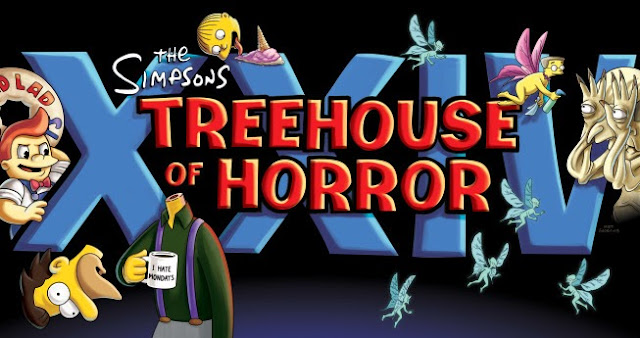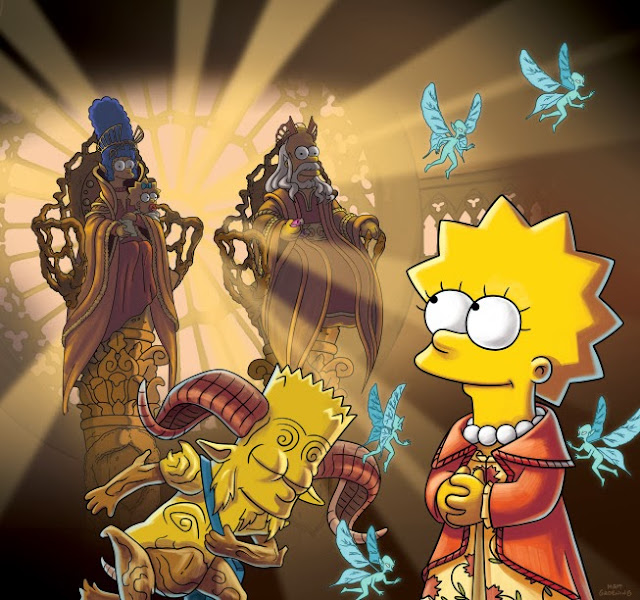
Longtime fans of THE SIMPSONS will probably remember that “Tree House of Horror” was the first episode Alf Clausen scored back in 1990. After Richard Gibbs had scored the first 13 episodes of the series, the producers wanted to make a musical change and went on a search for a new composer. After trying three other composers, Alf was given his “shot” at becoming the new composer. He was assigned the first-ever Halloween episode. The episode was, of course, unlike any of the others that had come before and would require three different scores for the three different stories being told. It would also require a slightly larger orchestra than we had used up to that point, and a 6-hour recording session instead of the standard 3-hour session. The producers agreed to everything and Alf went on to compose and record one of the iconic scores in the show’s history. Alf was awarded the permanent role of composer. 23 years, 23 “Tree Houses”, and 514 episodes later, we’ve added another chapter in the long musical history of the show.

In the last couple of years, the show has invited other artists to produce, design, or animate a couch gag for our Main Title sequence. For “Tree House of Horror XXIV” feature film director Guillermo del Toro (“Pacific Rim”, “Pan’s Labyrinth”) joined our list of guest artists. While everyone has been calling this a special “couch gag”, it really is a full-blown Main Title sequence PLUS the couch gag. It is a total reimagining of our full-length HD Main Title dressed up with classic horror/sci-fi/fantasy characters from movie and television history.
As for the music for this fantastic Main Title, it traveled an interesting road to the final version. Back in late June of this year, I received an email from Animation Co-Producer Richard Chung telling me that the del Toro Main Title would be part of a surprise screening at Comic Con 2013 and my job was to edit a temporary score for the clip. The cut I was sent had temp music already in it, mostly pulled from the movies “Frankenweenie” and “Beetlejuice”. I got a list of all the specific cues that had been used, then went to work reworking, re-timing, and generally polishing the existing temp music. I thought the temp score created at Film Roman was quite good, it just need a little “smoothing around the edges”.

I sent my version back to Film Roman and got positive feedback. Then it was forwarded over to Al Jean and he approved it as well. Job done – so I thought. A couple of days later I hear from Supervising Producer Larina Adamson that FOX says we cannot use the temp score with the “Frankenweenie” and “Beetlejuice” music in it because they were not going to license the music. At first I was rather surprised by this because it was a “temp score” for a “work in progress” that was being screened for what was essentially a private audience at Comic Con. If you live in Southern California, you have most likely attended – or been invited to – a test screening of a movie still in the editing stage. At these screenings it is explained to the audience that the film is being shown in a unfinished form, with some scenes possibly missing, most visual effects either missing or still in their temporary form, and with a temporary music score. It has been a common practice in Hollywood for many years now to use any music the director or film editor or music editor wants to put into the film as temp for test screenings. Everybody does it, so everybody gets away with using this music for free during the test screening process. Once the movie is final and released to the paying public, all music is paid for, either by hiring a composer and musicians or licensing existing music or both.
I couldn’t understand why FOX wasn’t treating this Comic Con screening the same way that they treated a test screening. But the more I thought about it, the more I understood it. This wasn’t a test screening where opinions were being sought. At Comic Con people were going to have cell phones with still and video cameras and would posting photos and video clips on social media. FOX just didn’t want to step on anyone’s toes so the Main Title got bounced back to me with instructions to dump the entire temp score and to replace it with music from our vast library of Clausen-composed Simpsons cues.

First I had a long conversation with Al Jean telling him that while I’d be happy to redo the score and would give it my best effort, I firmly asserted that the new score might not be as powerful and dramatic as the first temp score. Those scores from “Frankenweenie” and “Beetlejuice” were recorded with 90+ piece orchestras and choirs and had long melodic development. Our orchestra is about one-third the size and many of our cues are under 15 seconds long – this Main Title is 2:45, and would be the longest single musical sequence in the history of the show. Al said he understood, and trusted my judgment to produce a good temp score. Off to work I went.
In the end, I used snippets from eleven different scores going back twelve years in our show’s history. I submitted the new temp to Al, he had two small changes that I addressed, and that was that. That was the version of the temp score that the Comic Con audience heard on Saturday, July 20, 2013. Job done – so I thought.
Fast forward to music spotting for the final version of “Tree House of Horror XXIV” on August 22, 2013. At the session, I was fully prepared to discuss how Alf would now write a totally original score for the sequence, but instead Al Jean told me that he and everyone else really liked the temp and that they wanted Alf to recreate the temp with a few slight modifications.
SIDEBAR: The “temp score” in film & TV is a huge blessing and curse in our business. Ever since CDs and digital media made it very easy to put any music a director or producer’s heart desires into a soundtrack, they just grab anything by John Williams or Hans Zimmer or The Beatles or Lady Gaga and drop it in to a scene to “see how it plays”. When it plays great is when the problems begin. In the case of using an existing score, the composer hired to write the new score has now had a huge amount of their creativity stripped from them. Their job is now to compose something in the style of the temp that treads a delicate line between originality and plagiarism. In the case of using a song from a popular band or artist, the licensing of the song or artist may be cost prohibitive or simply unavailable because some artists don’t license their music for any reason. As a music editor, I’m often called upon to create a temp score and it always puts me in an awkward position. On the one hand, I am tasked with doing the best job possible, essentially “scoring” the film with existing cues – my main job is to please the producer or director in charge. On the other hand, the better the job I do at creating the temp score, the harder it becomes for the composer to lend his or her own voice to their score. The composer often ends up being a musical mimic, rather than an original contributor to the final product. There’s no good solution to this problem – it’s just the way things are done these days.
At least Alf was being asked to mimic himself in scoring the del Toro Main Title. So now I had to go back to my original edit of the temp score for Comic Con and reverse-engineer it. You see, when I was editing it, I did it all purely by sound. That means I listened to various cues, chose the ones that I thought would work for each scene in the sequence, then edited the music as need be to make it fit and highlight various moments. While I do all this with the greatest regard and respect for the music, I didn’t edit the temp score by referring to the printed music scores. Now I had to go back through the archives, pull the printed scores for each bit that I used, and try to figure out what I did editorially and translate it to bars and beats so that the score could be recreated on paper for our orchestra to record. That was a big task that took a few days, but I was able to do it. Alf & orchestrator Dell Hake then organized everything – which included writing a few new bits that Al Jean wanted to change from my temp score – and we broke it all down into 14 separate cues to be recorded then stitched together into one, seamless finished product.
All in all, I’m very proud of the final result. It plays beautifully, hit’s all the emotional notes perfectly, and sounds like it was recorded by a 90+ piece orchestra.

There’s no time for the music department to rest. No sooner did we finish this longest-most-complex-musical-sequence-ever than another, equally-complex-and-exciting-musical-sequence was presented to us. We’re working on it now and I’ll tell you all about it in the near future. Mark your calendars to watch for it when it airs on FOX on Sunday, November 24, 2013 (schedule subject to change).

 The title of this post refers to an old adage that’s pretty self-explanatory: when someone falls short of doing their job well and claims, “I didn’t have the latest widget (or doo-dad, or thingamajig),” or “I have the latest widget (or doo-dad, or thingamajig) but it’s broken (or the batteries died, or running last year’s software),” it often means that their skills are weak and it’s easier to blame their tools than accept responsibility for their own shortcomings.
The title of this post refers to an old adage that’s pretty self-explanatory: when someone falls short of doing their job well and claims, “I didn’t have the latest widget (or doo-dad, or thingamajig),” or “I have the latest widget (or doo-dad, or thingamajig) but it’s broken (or the batteries died, or running last year’s software),” it often means that their skills are weak and it’s easier to blame their tools than accept responsibility for their own shortcomings. In my
In my  That’s what it felt like this week. Maybe that sounds a bit dramatic, but the news just came so suddenly. Ever since this season began and people would ask me how much longer the show would last, I’d tell them that this was the final season of the actors’ current contracts and that, for the show to continue, a new deal would have to be struck sometime between December and next February.
That’s what it felt like this week. Maybe that sounds a bit dramatic, but the news just came so suddenly. Ever since this season began and people would ask me how much longer the show would last, I’d tell them that this was the final season of the actors’ current contracts and that, for the show to continue, a new deal would have to be struck sometime between December and next February.  Firday, September 9 was a pretty busy day for yours truly. I spent pretty much the entire day at FOX working on 4 different episodes of THE SIMPSONS.
Firday, September 9 was a pretty busy day for yours truly. I spent pretty much the entire day at FOX working on 4 different episodes of THE SIMPSONS.